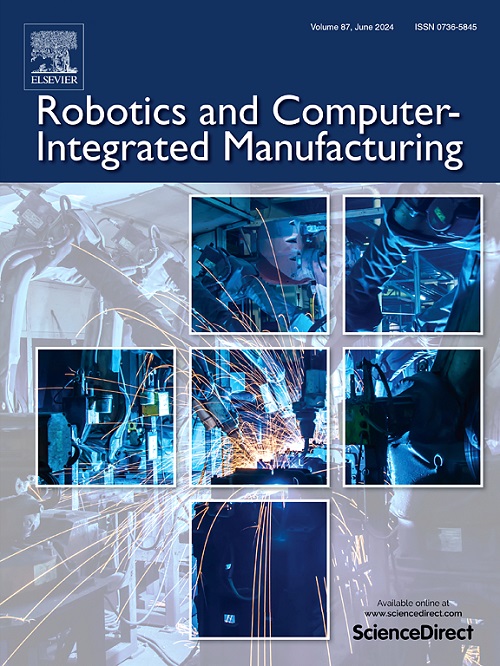提高再制造效率:一种基于教-学的人机共享工作站拆解线平衡问题遗传优化算法
IF 11.4
1区 计算机科学
Q1 COMPUTER SCIENCE, INTERDISCIPLINARY APPLICATIONS
引用次数: 0
摘要
人机协作技术利用了双方主体的互补能力,为再制造行业提供了多样化的操作场景。在本研究中,解决了人-机器人共享工作站拆解线平衡问题(HRSW-DLBP),其中人与机器人同时操作。HRSW-DLBP有助于在处理危险和复杂组件时快速释放组件的优先约束。认识到序列依赖建立时间(SDSTs)在实际应用中的普遍存在,本研究将HRSW-DLBP扩展为SDST,以更准确地模拟现实世界的场景。HRSW-DLBP-SDST比其前身提出了更复杂的挑战,后者不考虑这样的设置时间。因此,设计一个有效的方法来解决这个问题是至关重要的。考虑到HRSW-DLBP-SDST的NP-hard特性,本研究引入了一种针对大规模问题解决的基于教学-学习的遗传优化(GTLBO)算法,该算法结合了基于问题特征的双层编码和解码策略,并增强了局部搜索算子,以更好地与GTLBO结构保持一致。提出的GTLBO算法的性能在四种情况下与已建立的优化算法进行了基准测试,证明了其优越性。最后,将HRSW-DLBP-SDST应用于液晶电视拆卸场景,得到了多个最优分配方案。这些案例研究证实了该方法在解决HRSW-DLBP-SDST方面的有效性。本文章由计算机程序翻译,如有差异,请以英文原文为准。
Enhancing remanufacturing efficiency: a genetic teaching-learning-based optimisation algorithm for human-robot shared-workstation disassembly line balancing problem
Human-robot collaborative technology leverages the complementary capabilities of both agents, offering diversified operational scenarios for the remanufacturing industry. In this study, the human-robot shared-workstation disassembly line balancing problem (HRSW-DLBP) is addressed, where humans and robots operate concurrently. The HRSW-DLBP facilitates the rapid release of precedence constraints on components while processing both hazardous and complex components. Recognising the prevalence of sequence-dependent setup times (SDSTs) in practical applications, this study extends the HRSW-DLBP with SDST to more accurately model real-world scenarios. The HRSW-DLBP-SDST presents a more complex challenge than its predecessors, which do not consider such setup times. Therefore, devising an effective method for solving this problem is crucial. Given the NP-hard nature of the HRSW-DLBP-SDST, this study introduces a genetic teaching-learning-based optimisation (GTLBO) algorithm tailored for large-scale problem solving, incorporating a double-layer encoding and decoding strategy informed by the characteristics of the problem and enhancing local search operator to better align with the GTLBO structure. The performance of the proposed GTLBO algorithm was benchmarked against established optimisation algorithms across four cases, demonstrating its superiority. Finally, the HRSW-DLBP-SDST was applied to a liquid crystal display TV disassembly scenario, yielding multiple optimal allocation schemes. These case studies confirm the efficacy of the proposed method in resolving the HRSW-DLBP-SDST.
求助全文
通过发布文献求助,成功后即可免费获取论文全文。
去求助
来源期刊
CiteScore
24.10
自引率
13.50%
发文量
160
审稿时长
50 days
期刊介绍:
The journal, Robotics and Computer-Integrated Manufacturing, focuses on sharing research applications that contribute to the development of new or enhanced robotics, manufacturing technologies, and innovative manufacturing strategies that are relevant to industry. Papers that combine theory and experimental validation are preferred, while review papers on current robotics and manufacturing issues are also considered. However, papers on traditional machining processes, modeling and simulation, supply chain management, and resource optimization are generally not within the scope of the journal, as there are more appropriate journals for these topics. Similarly, papers that are overly theoretical or mathematical will be directed to other suitable journals. The journal welcomes original papers in areas such as industrial robotics, human-robot collaboration in manufacturing, cloud-based manufacturing, cyber-physical production systems, big data analytics in manufacturing, smart mechatronics, machine learning, adaptive and sustainable manufacturing, and other fields involving unique manufacturing technologies.

 求助内容:
求助内容: 应助结果提醒方式:
应助结果提醒方式:


